Dehydrating apples stands out as a time-tested method to capture the taste of this wonderful fruit. If you’re aiming for a healthy snack or seeking to extend your apple harvest, this guide will provide essential information about dehydrating apples and their nutritional benefits.
Understanding the Basics of Dehydrating Apples
Choosing the Right Apples for Dehydration
The first step to dehydrating apples is to select the right variety of apples. Opt for firm, ripe apples that have a good flavor when dried such as Fuji, Honeycrisp, Granny Smith, McIntosh, Crispin, Cortland, or Northern Spy. These varieties have a perfect balance of sweetness and tartness but also maintain their texture well during the dehydration process.
Preparing Apples for Dehydration
To prepare your apples for dehydration there are a few steps you should follow:
- Wash apples thoroughly
- Peel if desired (I like to use my apple corer, peeler, and slicer to peel, core, and cut the apples all at once). Apple skin does toughen slightly when dried. If you are planning to rehydrate and cook the apples, you may want to peel them before drying. If using the apples for a snack, leave the skin on for extra fiber.
- Core apples with an apple corer
- Slice apple uniformly with a knife and cutting board to ensure consistent drying. Aim for slices around 1/4 inch thick. You can also use a mandoline for even slices.
- Prevent your apple slices from turning brown: The best way to keep apples from browning is to submerge the sliced apples in a large bowl of salted water. Use a ratio of 1/2 teaspoon of kosher salt for every cup of room-temperature water. Soak the apples in the solution for about five minutes, then rinse them in a colander under running water.
The Dehydrating Process
Equipment Essentials for Dehydrating Apples
Investing in the right equipment streamlines the dehydrating process. A quality food dehydrator, parchment paper, and a sharp knife are indispensable tools. I love to use an apple corer, peeler, and slicer while making dehydrated apples because it makes the process so quick. While an oven can suffice, a dehydrator offers precise temperature control, ensuring optimal results.
Here is the equipment I typically use when making apple slices for dehydration.
Seasoning and Flavoring Options
Apple slices are delicious without any added seasoning but if you are feeling adventurous try adding some spices. You can really experiment with different seasonings and flavors to find a favorite to go with your apples. Dust your apple slices with cinnamon for a classic touch, or sprinkle with a hint of nutmeg for a more exotic taste. The beauty lies in customization, allowing you to tailor the taste to your liking.
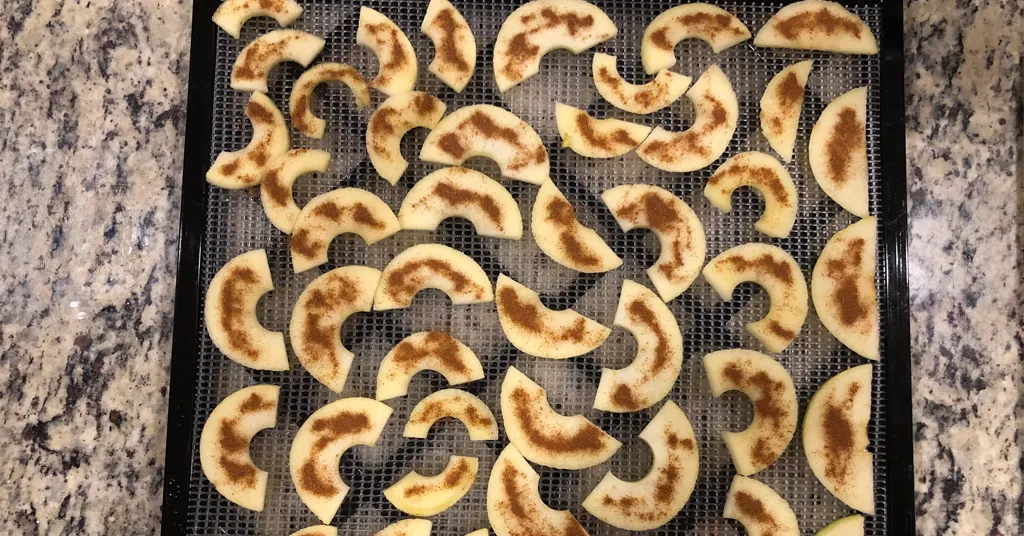
Temperature and Timing Guidelines
For dehydrating apples, set your dehydrator to around 130°F (54°C) for the best balance between preserving nutrients and expediting the dehydrating process. Expect the apples to take anywhere from 4 to 8 hours, depending on thickness and humidity. When done apple slices should feel dry and leathery and be spongy and still flexible.
Recipe for Dehydrating Apples
Easy dehydrator recipe and instructions for Dehydrating Apples
Ingredients
- Apples (Fuji, Honeycrisp, Granny Smith, McIntosh, Crispin, Cortland or Northern Spy work well)
- Salt ((Optional))
- Cinnamon ((Optional))
Instructions for Dehydrating Apples
- Wash apples thoroughly
- Peel if desired. (I like to use my apple corer, peeler, and slicer to peel, core, and cut the apples all at once). Apple skin does toughen slightly when dried. If you are planning to rehydrate and cook the apples, you may want to peel them before drying. If using the apples for a snack, leave the skin on for extra fiber.
- Core apples with an apple corer
- Slice apple uniformly with a knife and cutting board to ensure consistent drying. Aim for slices around 1/4 inch thick. You can also use a mandoline for even slices.
- Prevent your apple slices from turning brown: The best way to keep apples from browning is to submerge the sliced apples in a large bowl of salted water. Use a ratio of 1/2 teaspoon of kosher salt for every cup of room-temperature water. Soak the apples in the solution for about five minutes, then rinse them in a colander under running water.
- Add apple slices to mesh dehydrator trays making sure they do not overlap.
- If desired, sprinkle apple slices with cinnamon or other seasoning.
- Set your dehydrator to around 130°F (54°C).
- Expect apples to take anywhere from 4 to 8 hours to dehydrate, depending on thickness and humidity. Test doneness around the 4-hour mark and continue to check apple slices if they need more time.
- When done apple slices should feel dry and leathery and be spongy and still flexible.
- Place your apple slices in airtight containers or vaccum-sealed bags to shield them from moisture and air.
- Store in a cool, dark place to maintain flavor and texture over an extended period.

Get My Free Dehydrating Guide
Preserve the flavors of your favorite fruits and vegetables with my FREE comprehensive and beginner-friendly Dehydrating Guide.
Nutritional Advantages of Dehydrating Apples
Dehydrating Apples Concentrates Nutrients
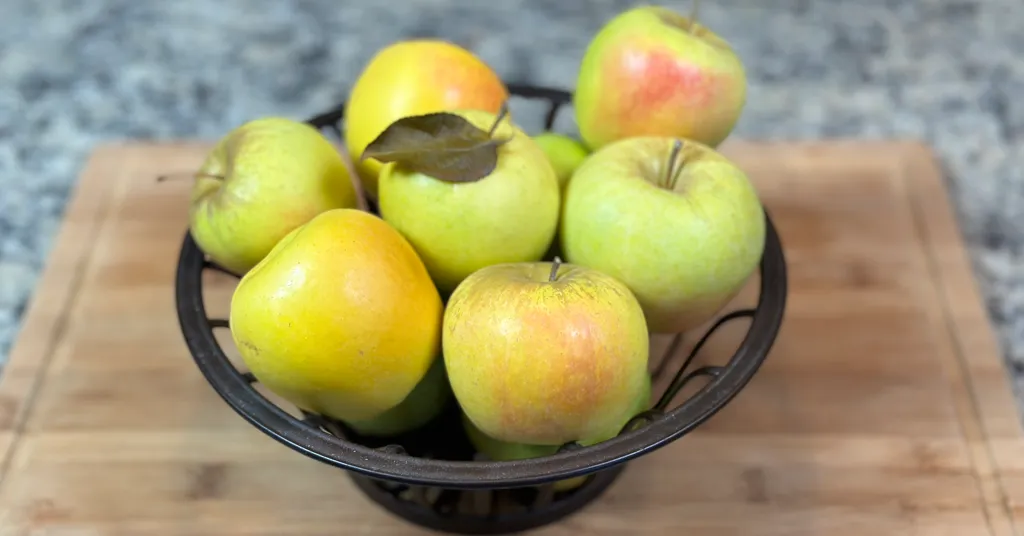
Healthy Snacking Made Easy
The portable nature of dehydrated apples makes them an ideal on-the-go snack. Say goodbye to unhealthy alternatives – these dehydrated apple slices provide a burst of natural energy without compromising on taste.
Storing and Enjoying Dehydrated Apples
Proper Storage Techniques
Preserving the quality of your dehydrated apples requires proper storage. Place them in airtight containers or vacuum-sealed bags to shield them from moisture and air. Store in a cool, dark place to maintain flavor and texture over an extended period.
Culinary Uses Beyond Snacking
Dehydrated apples aren’t limited to solo snacking. Incorporate them into your culinary creations – from oatmeal toppings to trail mix components, the possibilities are endless. Their versatility extends to both sweet and savory dishes, adding a touch of natural sweetness.
You could use your dehydrated apples in this delicious slow cooker apple cinnamon oats recipe and have a quick and tasty breakfast ready.

Join My Preserving Guide Facebook Group
Expert tips, tested recipes, and vibrant discussions on canning, dehydrating, freezing, and all things food preservation!
Common Concerns When Dehydrating Apples
Is Sugar Necessary When Dehydrating Apples?
One common misconception is that adding sugar enhances the dehydration process. However, with naturally sweet apple varieties, the addition of sugar is unnecessary. Embrace the authentic taste of the fruit without artificial additives.
Rehydrating Dehydrated Apples
Should you desire the plumpness of fresh apples, rehydration is an option. Soak the dehydrated slices in warm water for approximately 30 minutes, and they’ll regain a texture remarkably close to their fresh counterparts.
Dehydrating apples transforms this common fruit into a convenient, flavorful, and nutrient-rich snack. Elevate your snacking experience, reduce food waste, and savor the natural sweetness of dehydrated apples in every delicious bite.
Looking for additional apple-preserving methods? Try some of the preserving recipes below:
Recipe Card
Dehydrated Apples
Equipment
Ingredients
- Apples Fuji, Honeycrisp, Granny Smith, McIntosh, Crispin, Cortland or Northern Spy work well
- Salt (Optional)
- Cinnamon (Optional)
Want to Save this Recipe?
Instructions
- Wash apples thoroughly
- Peel if desired. (I like to use my apple corer, peeler, and slicer to peel, core, and cut the apples all at once). Apple skin does toughen slightly when dried. If you are planning to rehydrate and cook the apples, you may want to peel them before drying. If using the apples for a snack, leave the skin on for extra fiber.
- Core apples with an apple corer
- Slice apple uniformly with a knife and cutting board to ensure consistent drying. Aim for slices around 1/4 inch thick. You can also use a mandoline for even slices.
- Prevent your apple slices from turning brown: The best way to keep apples from browning is to submerge the sliced apples in a large bowl of salted water. Use a ratio of 1/2 teaspoon of kosher salt for every cup of room-temperature water. Soak the apples in the solution for about five minutes, then rinse them in a colander under running water.
- Add apple slices to mesh dehydrator trays making sure they do not overlap.
- If desired, sprinkle apple slices with cinnamon or other seasoning.
- Set your dehydrator to around 130°F (54°C).
- Expect apples to take anywhere from 4 to 8 hours to dehydrate, depending on thickness and humidity. Test doneness around the 4-hour mark and continue to check apple slices if they need more time.
- When done apple slices should feel dry and leathery and be spongy and still flexible.
- Place your apple slices in airtight containers or vacuum-sealed bags to shield them from moisture and air.
- Store in a cool, dark place to maintain flavor and texture over an extended period.
Editorial Process
At Preserving Guide, I take pride in my thorough and impartial approach to recipe and product reviews. Read my editorial process for detailsRobin
Robin Phelps has been preserving food for her family for over 20 years. Today, Robin is a full-time home preservation blogger and coach. Join Robin to learn how to easily make delicious and safe homemade preserved items.



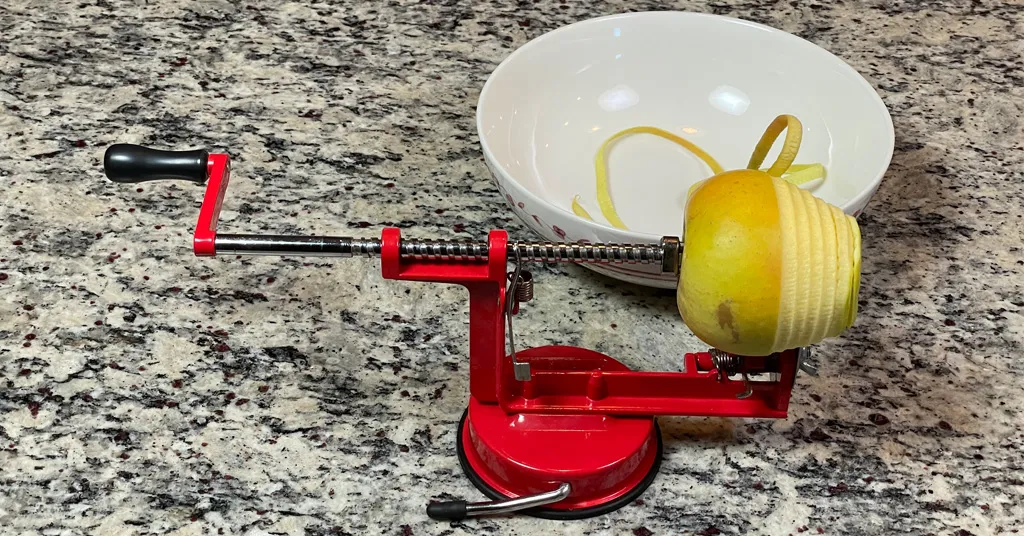
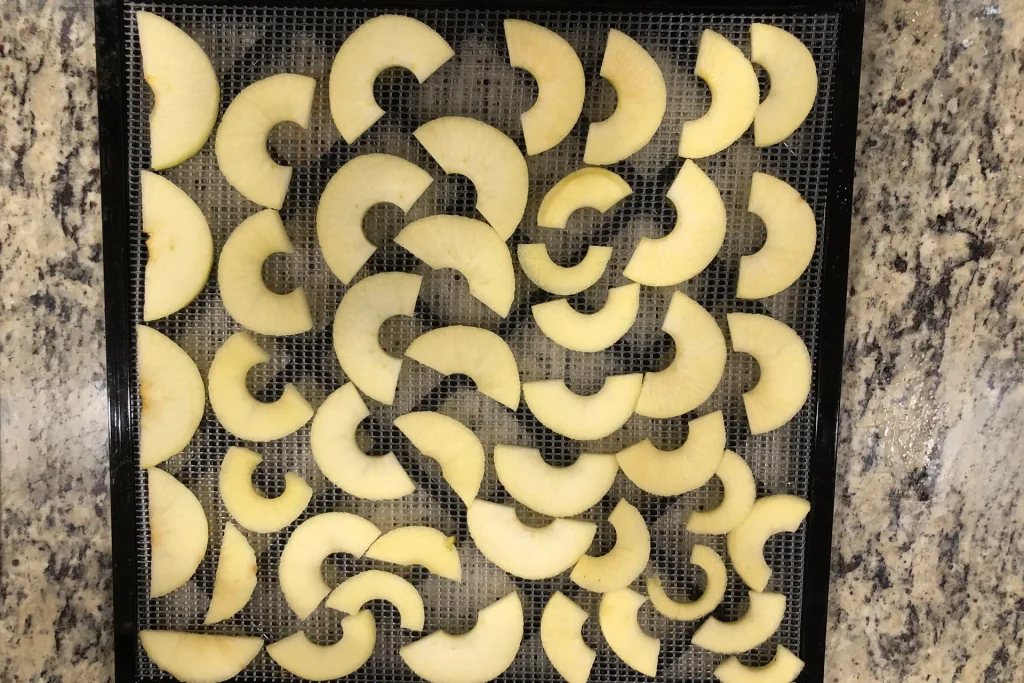







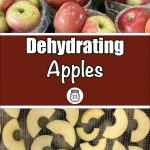


Our friends make dried apple slices and they are so good. I would love to try doing this! A dehydrator would be such a great tool to have.